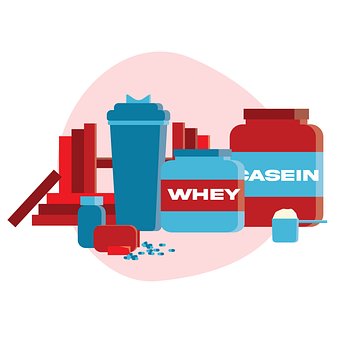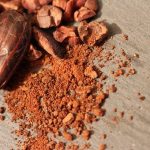It’s agreed by many that whey protein is a very helpful supplement. This supplement can improve your workout results, help you build muscle more effectively, or make it easier to lose fat.
Many people take protein supplements in the form of powder, drinks, or bars. Proteins found in many supplements are often derived from dairy, specifically whey.
There are two types of whey protein, whey isolate and whey concentrate. The article explains the differences between whey protein concentrate and whey protein isolate and whether one form is better to use.
But which kind of whey protein should you choose? Are you interested in learning about the similarities and differences between whey isolate and concentrate, as well as the pros and cons of each according to science? If so, read on for a thorough explanation.
After reading this article, you will be able to make an informed decision about which whey protein is right for you based on your individual goals.
Whey Protein
Whey protein powder is a protein supplement made from milk. It’s a popular choice for people who are looking to build muscle, because it contains all the essential amino acids that your body needs to build muscle.
This is because whey:
- Is a complete protein, containing all the essential amino acids your body needs
- Is very rapidly absorbed by your body
- Has a high biological value, meaning your body can make full use of it
Whey protein is superior to other protein sources for athletes and people who exercise regularly because it is a complete protein containing all the essential amino acids, it is very rapidly absorbed, and has a high biological value.
Whey protein is especially important because it contains all 9 essential amino acids (EAAs) that your body needs. This protein is also rich in branched-chain amino acids (BCAAs) leucine, isoleucine, and valine. It contains up to 20% of its weight in these BCAAs.
The rate at which your body digests and absorbs whey protein is much faster than casein and other similar proteins. Peer-reviewed studies show that regular whey protein consumption can:
- Enhance the rate of exercise recovery
- Increase muscle growth more than other types of protein
- Suppress appetite
- Speed up fat loss
- Decrease the loss of lean muscle mass during fat loss
Much of the protein found in protein bars, drinks and powders is from milk. The liquid that is left over when milk is processed into cheese or yogurt is called whey.
This liquid contains whey protein, which is a fast-digesting protein. 20% of the protein in milk is whey, and the other 80% is casein.
Both whey and casein proteins are considered high quality because they contain all the amino acids needed by the body. Whey is beneficial for increasing the production of new protein in your muscles.
There are several types of whey protein that can be used as a supplement. There are two main types of whey protein: whey isolate and whey concentrate. There are many types of milk, which are produced using different processing techniques and vary slightly in their nutritional content.
Whey protein is the fast-digesting part of dairy protein. There are two main types of whey protein supplements – whey isolate and whey concentrate.
Similarities and Differences between Whey Isolate and Whey Concentrate
Liquid whey is a byproduct of manufacturing cheese or yogurt and both whey isolate and whey concentrate come from it.
The process of separating liquid whey into whey protein concentrate and whey protein isolate is called ultrafiltration. After ultrafiltration, the resulting concentrate contains a high percentage of protein, plus lactose and milk fat.
While whey protein concentrate is only minimally processed, whey protein isolate goes through a more extensive filtration process. So, whey isolate has 90% or more protein.
Difference Between Whey Isolate and Whey Concentrate
The main difference between whey isolate and concentrate is the amount of fat and lactose. Whey isolate has less fat and lactose than concentrate. These differences are caused by the processing methods.
The whey left over from cheese or yogurt production is collected and goes through several processes to increase its protein content.
If a high enough concentration of protein is reached, the liquid can be dried to create whey powder concentrate, which has a protein content of up to 80%. The other 80% of the whey concentrate powder consists of carbohydrates and fats.
If different processing steps are used to reduce the fat and carbohydrate content of whey, a whey isolate powder containing 90% or more protein by weight can be produced.
Overall, the steps involved in processing whey isolate result in a higher concentration of protein per serving, and less fat and carbohydrates.
There is little difference between the amino acids found in whey from cows and whey from goats, since they come from the same kind of proteins.
Whey isolate also has a lower lactose content in addition to having a lower total carbohydrate content. This makes it a more viable option for people who are intolerant to lactose.
Both whey protein isolate and whey protein concentrate are likely to contain a low enough amount of lactose for those who are intolerant to use.
The cost of whey protein concentrate is lower than the cost of whey protein isolate. Generally, whey isolate is more expensive than whey concentrate.
This means that although whey isolate is a purer form of protein, you can get the same amount of protein from whey concentrate, which is often cheaper.
Several studies have found that whey protein can have positive effects for people who are physically active. A study with 192 people found that taking whey protein supplements helps with muscle and strength.
There is not strong evidence to suggest that whey isolate and concentrate have different effects in your body, despite the minor differences in nutritional content. How much protein you eat in a day is one of the most important factors. Most of the protein that you should eat in a day should come from sources that are high quality, such as dairy, eggs, and poultry.
If an equivalent dose of whey isolate and concentrate are taken, they will both produce similar effects.
It’s important to note that many supplements contain a blend of protein that includes both whey isolate and whey concentrate.
There are benefits of whey protein for active individuals, but it is not clear if there is a difference between whey isolate and whey concentrate.
Nutritional Facts
About 130 calories, 25 grams of protein, 2 grams of fat, and 3 grams of carbs can be found in a 30-gram scoop of unflavored whey protein concentrate.
A 30-gram scoop of whey protein isolate contains about 110 calories, 27 grams of protein or more, 0 grams of fat, and 0 grams of carbs.
Making whey protein isolate removes lactose and milk fat.
Price
Whey protein isolate is more expensive to produce than whey protein concentrate because it requires a more complex manufacturing process. An equivalent serving of whey isolate typically costs 25-40% more than a serving of whey concentrate.
Amino Acid Profiles
Whey isolate and whey concentrate have the same amino acid profiles because they come from the same source (liquid whey).
Whey protein powder that is either a concentrate or an isolate has higher levels of important amino acids, including EAAs and BCAAs, than other types of protein powder.
Whey protein’s high levels of essential amino acids (EAAs) and branched chain amino acids (BCAAs) help it promote exercise recovery and muscle growth more effectively than other protein supplements.
Whey Isolate vs. Whey Concentrate Pros and Cons
The main difference between whey protein isolate and whey protein concentrate is the amount of lactose and fat they contain.
The most noticeable difference between isolate and concentrate for most people is the price tag. A price that is 25-40% higher is not usually worth paying for a whey isolate that has a few extra grams of protein.
What about the other macronutrients? The best possible quality of whey protein would have no carbs or fat.
Whey protein concentrate contains 3 grams of carbs and 2 grams of fat per serving, which is still allowed on even the strictest low-carb or low-fat diets.
There are significant differences between whey isolate and concentrate in terms of the protein fractions they contain, even though they have the same amino acid profile.
Whey concentrate has a higher amount of intact protein fractions and bioactive peptides compared to whey isolate. The protein in whey isolate is often altered in shape due to the intensive processing during manufacturing.
Some potential effects associated with the intact whey protein fractions and bioactive peptides in whey concentrate include:
- Antioxidant activity
- Antihypertensive (blood pressure lowering) effects
- Reductions in blood glucose
- Heart health benefits
Some researchers think whey concentrate has additional health benefits over whey isolate because it has a greater number of intact proteins with their original three-dimensional shape.
Should you take whey isolate or whey concentrate?
Consider taking whey concentrate over whey isolate. Whey concentrate is a more affordable option that is just as effective, if not more effective, in helping with exercise recovery and promoting muscle growth. It also contains negligible amounts of carbs and fat.
Many people who are lactose intolerant can still consume low amounts of lactose found in whey concentrate.
In addition to that, whey concentrate also contains intact protein fractions that may contribute to your health in a variety of ways that researchers haven’t yet studied thoroughly.
In contrast, here are a few reasons someone might choose whey isolate instead of whey concentrate:
- Extreme lactose intolerance
- Following a diet that allows few or no carbs, such as the medical ketogenic diet for epilepsy
- Following a zero fat diet (which we don’t recommend)
- More protein per serving
Unless you are lactose intolerant or you have a very restrictive diet, you don’t need to pay extra for whey isolate.
How to Take Whey Concentrate or Whey Isolate
There are a few things to keep in mind if you want to make the most out of taking whey protein powder. Whether you choose whey concentrate or whey isolate, it’s important to follow these best practices.
Timing
If you want to build muscle or recover faster after training, whey shakes around training sessions is a good strategy. It is not a big difference whether you consume your protein shake before or after working out, but it is wise to have it as close to the training as possible.
If you are trying to increase your daily protein intake or replace meals, the timing is not as important. To use whey protein, mix it with water or milk and drink it with a meal or as a meal replacement.
Amount of Protein
Protein is necessary for burning fat, retaining muscle during fat loss, and building muscle.
According to the United States Institute of Medicine, the recommended daily allowance for protein is 56 grams per day for adult men and 46 grams per day for adult women but these numbers are given as a baseline to maintain a healthy diet and vary greatly by individual and goal.
If you are an athlete or working out on a regular basis you may need more protein to build muscle and help your body recover.
Research has shown that consuming enough protein on a daily basis can help reduce appetite, promote weight loss, increase your metabolism, and speed up post-exercise recovery time.
We recommend that you get between 25 and 30 percent of your daily calories from protein. If you eat 2000 calories a day, you should have between 125 and 150 grams of protein. Whey protein is a good protein source that is also affordable. It can help you get 25% of your daily calories from protein.
Conclusion
Whey isolate is processed differently than whey concentrate, and as a result contains more protein and fewer carbs and fat per serving. Although there are some nutritional differences between these two types of whey protein, they are not very significant. Additionally, there is not a lot of evidence to suggest that these two types of whey protein have different effects.
If you are on a diet that limits your intake of fat, carbs, or lactose, whey isolate may be a good option for you, even though it is usually more expensive.
If you take a slightly higher dosage of whey concentrate, you can receive the same amount of protein that you would from a whey isolate product, but it would be cheaper.
Whichever whey protein you choose, it is a high-quality protein that will help you attain your daily recommended intake.









